Sweet Corn
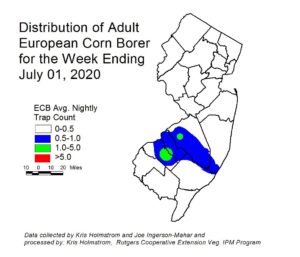 European corn borer (ECB) moth catches have remained steady at very low levels over the past week. At this time, activity is highest in Gloucester and Camden counties (see ECB map at left). Catches are widely dispersed. Above threshold (12%) larval infestations continue into the northern counties. Larval infestations should be expected to continue for another week or so.
European corn borer (ECB) moth catches have remained steady at very low levels over the past week. At this time, activity is highest in Gloucester and Camden counties (see ECB map at left). Catches are widely dispersed. Above threshold (12%) larval infestations continue into the northern counties. Larval infestations should be expected to continue for another week or so.
The highest nightly trap catches of ECB for the week ending 7/01/20 are as follows:
| Medford 2 | Elm 1 | Springdale 1 |
| Blairstown 1 | Long Valley 1 | Tabernacle 1 |
| Downer 1 | New Egypt 1 | |
| Eldora 1 | Port Colden 1 |
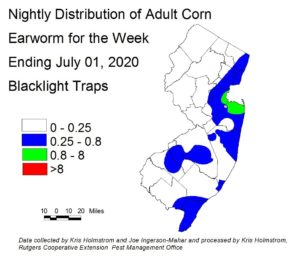 Corn earworm (CEW) moth captures stayed largely unchanged in blacklight traps this past week. This lingering population is somewhat heavier than normal for this time of year, and silking corn will need protection from this pest. Blacklight catches were highest overall along the coast (see map at left).
Corn earworm (CEW) moth captures stayed largely unchanged in blacklight traps this past week. This lingering population is somewhat heavier than normal for this time of year, and silking corn will need protection from this pest. Blacklight catches were highest overall along the coast (see map at left).
The highest nightly trap catches of CEW in black light traps for the week ending 7/01/20 are as follows:
| Matawan 4 | Eldora 1 | Pedricktown 1 |
| Allentown 1 | Elm 1 | Sergeantsville 1 |
| Cinnaminson 1 | Green Creek 1 | Springdale 1 |
| Downer 1 | Milltown 1 | Tabernacle 1 |
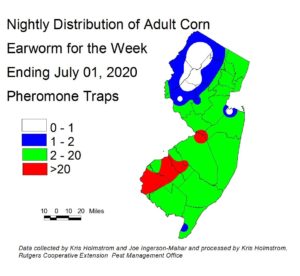 CEW pheromone traps continue to catch moths in numbers that range from nearly nothing to those representing 3-4 day silk schedules (see CEW pheromone map at left). The number of pheromone traps deployed is much lower, resulting in much broader color bands on the map. CEW activity in this network, however clearly indicates a highly variable but economically important population in the state at this time.
CEW pheromone traps continue to catch moths in numbers that range from nearly nothing to those representing 3-4 day silk schedules (see CEW pheromone map at left). The number of pheromone traps deployed is much lower, resulting in much broader color bands on the map. CEW activity in this network, however clearly indicates a highly variable but economically important population in the state at this time.
The highest nightly trap catches of CEW in pheromone traps for the week ending 7/01/20 are as follows:
| Monroeville 35 | Berlin 20 | Dayton 5 |
| Woodstown 24 | Pedricktown 14 | East Vineland 4 |
| Crosswicks 22 | Elm 12 | Folsom 4 |
| Springdale 22 | Jones Island 9 | Farmingdale 3 |
Silking Spray Schedules*:
South – 3-4 days
Central – 4 days
North – 6-7 days
*These recommendations are based on regional catches. Adhere to tighter spray schedules if indicated by local trap catches. Synthetic pyrethroids alone should NOT be used for corn earworm (CEW) protection on silking corn, or for fall armyworm (FAW) management at any stage. Control with these materials is very inconsistent.
Pepper weevil
No weevils have been caught as yet. Traps are continuing to be deployed on farms in the area.
If anyone wants pheromone traps or participate in a project of evaluating different lures, please contact Joe Ingerson-Mahar, mahar@sebs.rutgers.edu; phone: 856-889-5718.
Pumpkins and Winter Squash
For pumpkin and related crop fields now emerging, it is important to remember that the initial threat will be from striped cucumber beetles. Most seeds now come with a pre-applied insecticide to limit injury from this pest. However, growers should be alert to the possibility that untreated seeds may be fed upon heavily by cucumber beetles, resulting in bacterial wilt in a few weeks, or outright death of seedlings from excessive feeding. Scout 5 plants each in 10 random locations. If beetles are found to be feeding at more than two sites, consider an insecticide application to limit damage. It is unlikely that this situation will occur if seeds were pre-treated. Fields that are now beyond the 4 true leaf stage with plants gaining mass quickly are at much less risk from cucumber beetle feeding.
A cucurbit downy mildew (CDM) sentinel plot has been established at Snyder Farm in Hunterdon County. This plot, consisting of pumpkin, watermelon, cantaloupe, butternut, acorn, cucumber and kabocha squash will be used to indicate the presence of cucurbit downy mildew in the region, and what crops are affected. For regional information on this important disease, see the Cucurbit Downy Mildew Forecast webpage: http://cdm.ipmpipe.org/. With reports of CDM in North Carolina, the current forecast has New Jersey outside of the risk zone.
Tomatoes
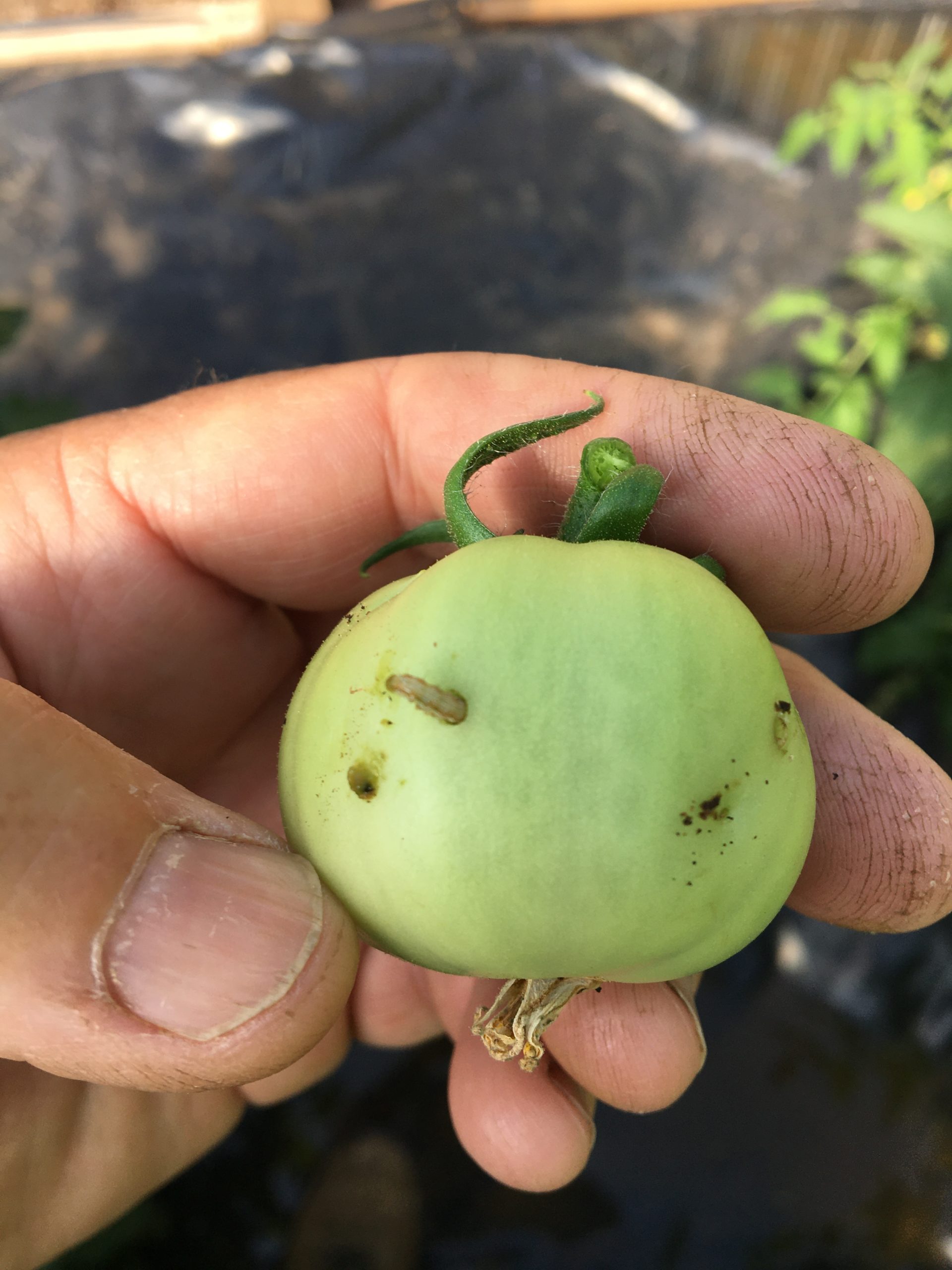 Tomato fruitworm (CEW) are still infesting green fruit in high tunnel and field tomatoes in Hunterdon County, although infestation rates are well below 1%. While this is typically a late summer occurrence, it is important that growers check plantings that have fruit present for infestation s of this pest. High tunnels do not offer protection from CEW or other caterpillar pests of tomato. CEW moths will lay eggs on the uppermost flower clusters. As these eggs hatch, larvae will bore into fruit in the upper and outer canopy (see photo at left). While infestations at this time may not result in significant fruit loss, actual losses are somewhat unpredictable. If tomato fruitworm infestations are found at 3 or more sites in a 10 site sample in the field, or in more than one site in a 5 site sample (as in a high tunnel), it may be time to apply an insecticide to limit further damage, especially if CEW moths are still being captured in local traps. A complete list of insecticides for this pest may be found in the Tomato Section of the Commercial Vegetable Production Recommendations. Note that the insecticide Entrust is OMRI approved. Avoid applying insecticides that carry a “M” or “H” designation for bee toxicity while bees are active in the field.
Tomato fruitworm (CEW) are still infesting green fruit in high tunnel and field tomatoes in Hunterdon County, although infestation rates are well below 1%. While this is typically a late summer occurrence, it is important that growers check plantings that have fruit present for infestation s of this pest. High tunnels do not offer protection from CEW or other caterpillar pests of tomato. CEW moths will lay eggs on the uppermost flower clusters. As these eggs hatch, larvae will bore into fruit in the upper and outer canopy (see photo at left). While infestations at this time may not result in significant fruit loss, actual losses are somewhat unpredictable. If tomato fruitworm infestations are found at 3 or more sites in a 10 site sample in the field, or in more than one site in a 5 site sample (as in a high tunnel), it may be time to apply an insecticide to limit further damage, especially if CEW moths are still being captured in local traps. A complete list of insecticides for this pest may be found in the Tomato Section of the Commercial Vegetable Production Recommendations. Note that the insecticide Entrust is OMRI approved. Avoid applying insecticides that carry a “M” or “H” designation for bee toxicity while bees are active in the field.

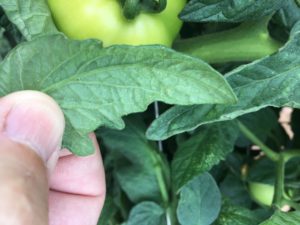 Two-spotted spider mites (TSSM) are becoming a more common occurrence in tomato fields now that warm weather has dominated for some time. These pests can build to high populations quickly and are a particular nuisance in high tunnels. Check two complete leaves each on 5 consecutive plants in 10 random locations in a planting. Look for the characteristic mite “stipple”, or whitish pin spots on the upper surface of the leaf (see photo at left). A check of the underside of the leaf should reveal the actual mites (photo at right). Be sure to take some samples from field or tunnel edges as this is often from where TSSM will enter the planting. Consider an miticide application if TSSM are found at more than one site in the sample. Miticide choices are found in the Tomato Section of the Commercial Vegetable Production Recommendations.
Two-spotted spider mites (TSSM) are becoming a more common occurrence in tomato fields now that warm weather has dominated for some time. These pests can build to high populations quickly and are a particular nuisance in high tunnels. Check two complete leaves each on 5 consecutive plants in 10 random locations in a planting. Look for the characteristic mite “stipple”, or whitish pin spots on the upper surface of the leaf (see photo at left). A check of the underside of the leaf should reveal the actual mites (photo at right). Be sure to take some samples from field or tunnel edges as this is often from where TSSM will enter the planting. Consider an miticide application if TSSM are found at more than one site in the sample. Miticide choices are found in the Tomato Section of the Commercial Vegetable Production Recommendations.
Brown Marmorated Stink Bug
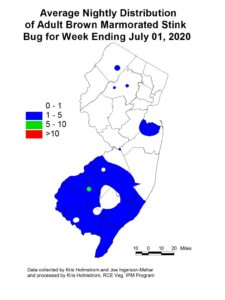 Brown marmorated stink bugs (BMSB) have been coming to blacklight traps, and catches are generally heavier in southern New Jersey. While this pest has generally declined as a threat to peppers, it remains a significant threat to tree fruit.
Brown marmorated stink bugs (BMSB) have been coming to blacklight traps, and catches are generally heavier in southern New Jersey. While this pest has generally declined as a threat to peppers, it remains a significant threat to tree fruit.
The highest nightly catches of BMSB in black light traps for the week ending 7/01/20 are as follows:
| Downer 7 | Eldora 3 | Matawan 2 |
| Prdricktown 4 | Green Creek 3 | Medford 2 |
| Tabernacle 4 | East Vineland 2 | New Egypt 2 |
| Centerton 4 | Jones Island 2 | Woodstown 2 |
2020 Vegetable IPM Program Personnel
Kris Holmstrom and Joe Ingerson-Mahar would like to acknowledge the IPM Field Technicians for this season:
Allison Cormier
Patrick King
Kelly Landers
Kaitlin Quinn
James Rodgers
Without the assistance of these individuals, much of the information presented in this publication would be unobtainable. We are grateful for all their help and hard work.

